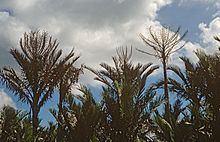Metroxylon sagu
| Sago Palm | |
|---|---|
 |
|
| Sago palms with characteristic terminal inflorescence/infructescence (West Seram, Maluku, Indonesia) | |
| Scientific classification | |
| Kingdom: | Plantae |
| (unranked): | Angiosperms |
| (unranked): | Monocots |
| (unranked): | Commelinids |
| Order: | Arecales |
| Family: | Arecaceae |
| Genus: | Metroxylon |
| Species: | M. sagu |
| Binomial name | |
|
Metroxylon sagu Rottb. |
|
| Synonyms | |
|
|
Metroxylon sagu (true sago palm) is a species of palm in the genus Metroxylon, native to tropical southeastern Asia, namely Indonesia (western New Guinea, and the Moluccas), Papua New Guinea, Malaysia (both Peninsular Malaysia and Sarawak) and possibly also the Philippines (though may have been introduced there). It is also naturalised in Thailand, in the Indonesian islands of Java, Kalimantan, Sumatra, and in the Solomon Islands.
True sago palm is a suckering (multiple-stemmed) palm, each stem only flowering once (hapaxanthic) with a large upright terminal inflorescence. A stem grows 7–25 m tall before it ends in an inflorescence. Before flowering, a stem bears about 20 pinnate leaves up to 10 m long. Each leaf has about 150-180 leaflets up to 175 cm long. The inflorescence, 3-7.5 m tall and wide, consists of the continuation of the stem and 15-30 upwardly-curving (first-order) branches spirally arranged on it. Each first-order branch has 15-25 rigid, distichously arranged second-order branches; each second-order branch has 10-12 rigid, distichously arranged third-order branches. Flower pairs are spirally arranged on the third-order branches, each pair consisting of one male and one hermaphrodite flower. The fruit is drupe-like, about 5 cm in diameter, covered in scales which turn from bright green to straw-coloured upon ripening.
The tree is of commercial importance as the main source of sago, a starch obtained from the trunk by washing the starch kernels out of the pulverized pith with water. This starch is used in cooking for puddings, noodles, breads, and as a thickener. In the Sepik River region of New Guinea, pancakes made from sago are a staple food, often served with fresh fish. Its leaflets are also used as thatching which can remain intact for up to five years. The dried petioles (called gaba-gaba in Indonesian) are used to make walls and ceilings; they are very light, and therefore also used in the construction of rafts.
...
Wikipedia
